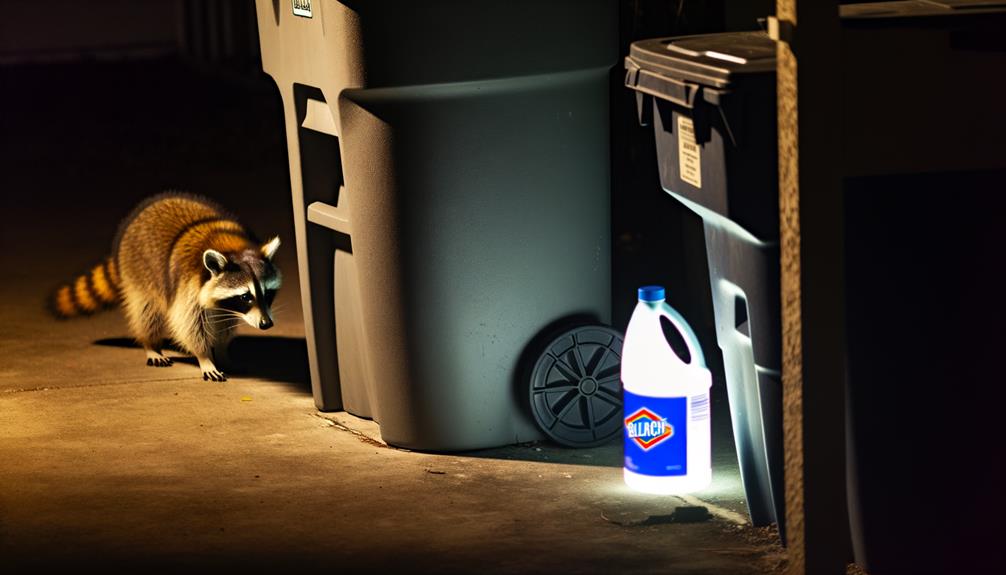Does Bleach Keep Raccoons Away?
Bleach can be an effective raccoon deterrent because it disrupts their sense of smell, making the surroundings unpleasant for them. Its main ingredient, sodium hypochlorite, contributes to this deterrent effect.
However, the use of bleach requires careful consideration due to potential health risks to humans and pets, as well as environmental hazards such as soil and water contamination. Alternative repellents like predator urine, motion-activated devices, and ultrasonic devices might offer safer and more compassionate solutions.
For effective and safe raccoon management strategies, several factors must be taken into account, ensuring best and sustainable outcomes. Discover detailed insights into deterrent methods and safety considerations.

Key Takeaways
- Bleach can disrupt raccoons' olfactory receptors, creating a hostile environment and deterring them.
- The chemical properties of bleach make it an effective raccoon repellent by masking food scents.
- Using bleach can pose health risks to humans and pets through toxic fumes and potential ingestion.
- Environmental hazards of bleach include soil and water contamination from chemical runoff.
- Bleach is less preferred compared to humane and environmentally friendly repellent methods.
Understanding Raccoon Behavior
Raccoons, Procyon lotor, exhibit a range of complex behaviors driven by their nocturnal and omnivorous nature, necessitating a thorough understanding for effective wildlife management.
Their behavioral repertoire includes intricate foraging strategies, dexterous manipulation of objects, and an advanced capacity for problem-solving. These behaviors are often influenced by urban environments, where raccoons exploit anthropogenic resources.
For practitioners in wildlife management, recognizing these adaptive behaviors is pivotal for developing humane and effective strategies to mitigate human-raccoon conflicts. This involves understanding their dietary preferences, habitat requirements, and social structures.
Effective management requires a multi-faceted approach that integrates ecological knowledge with practical interventions, ensuring that raccoon populations are controlled without compromising their ecological role or welfare.
Common Raccoon Deterrents
Employing an array of deterrents is essential for managing raccoon activity and minimizing human-wildlife conflicts effectively. Various techniques can be utilized to achieve this objective, each leveraging different mechanisms to repel raccoons.
Here are four common deterrents:
- Fencing: Installing secure, raccoon-proof fencing with a height of at least four feet and buried at least six inches underground to prevent digging.
- Motion-Activated Devices: Utilizing devices such as sprinklers or lights that activate upon detecting movement to startle and discourage raccoons.
- Chemical Repellents: Applying commercially available raccoon repellents containing predator urine or capsaicin around perimeters and entry points.
- Ultrasonic Devices: Deploying ultrasonic repellent devices that emit high-frequency sounds unpleasant to raccoons but inaudible to humans.
These methods collectively contribute to a thorough raccoon management strategy.
How Bleach Works
Bleach functions as an effective raccoon deterrent primarily through its chemical repellent properties, which disrupt the animals' olfactory receptors.
The potent odor of bleach can create a hostile environment for raccoons, compelling them to vacate affected areas.
Understanding the mechanism by which bleach impacts wildlife behavior is essential for implementing safe and effective deterrent strategies.
Chemical Repellent Properties
Utilizing its active ingredient, sodium hypochlorite, bleach acts as a potent chemical repellent by disrupting the cellular integrity of organic matter, thereby deterring raccoons through its strong odor and caustic properties. Sodium hypochlorite's efficacy as a repellent can be attributed to its ability to oxidize and break down organic compounds, creating an environment that is inhospitable to raccoons.
Key mechanisms include:
- Protein Denaturation: Sodium hypochlorite denatures proteins, impairing cellular functions.
- Lipid Peroxidation: It disrupts cell membranes by peroxidizing lipids, compromising cell structure.
- Nucleic Acid Damage: It can cause mutations or breaks in DNA and RNA, hindering replication.
- Microbial Inhibition: It reduces microbial populations, decreasing the availability of food sources.
These properties collectively make bleach a formidable chemical repellent against raccoons.
Odor's Impact on Wildlife
The potent scent of sodium hypochlorite, a primary active component in bleach, greatly influences wildlife behavior by creating an aversive environment that raccoons and other animals instinctively avoid.
This chemical compound disrupts the olfactory receptors of raccoons, making the area unpleasant and uninhabitable for them. The sensory irritation caused by bleach's strong fumes effectively deters these nocturnal foragers from venturing into treated areas.
For those aiming to protect property and ensure public health, the deployment of bleach as a deterrent can be an efficient, albeit temporary, solution. However, it is vital to take into account the broader ecological impact and potential harm to non-target species when utilizing such chemical repellents.
Employing this method requires careful application and adherence to safety guidelines.
Bleach Vs. Other Repellents
Comparative analysis between bleach and alternative repellents reveals significant differences in efficacy, safety, and environmental impact when addressing raccoon deterrence. Bleach, while potent, can pose risks to both human health and the environment. Conversely, other repellents may offer more targeted and safer solutions.
- Ammonia: Known for its strong odor, ammonia can be effective but also carries health risks similar to bleach.
- Pepper Spray: Non-toxic and efficient, pepper spray deters raccoons without long-term environmental harm.
- Ultrasonic Devices: These devices emit high-frequency sounds, imperceptible to humans, effectively deterring raccoons without chemical use.
- Natural Repellents: Solutions like predator urine or essential oils (e.g., peppermint) provide environmentally friendly deterrence with minimal health risks.
Each method has its unique advantages and limitations, necessitating careful consideration.
Safety Concerns With Bleach
When considering the use of bleach as a repellent for raccoons, it is important to address its inherent toxicity and potential health risks to humans and animals alike.
Additionally, bleach poses significant environmental hazards, including soil and water contamination.
Effective management strategies must hence balance efficacy with stringent safety protocols to mitigate these risks.
Toxicity and Health Risks
Exposure to bleach can result in severe health complications for raccoons, including respiratory distress, skin burns, and potential systemic toxicity. When considering humane and effective wildlife control methods, it is essential to understand the risks associated with bleach. Direct exposure or inhalation can lead to:
- Respiratory Issues: Inhalation of bleach fumes can cause significant respiratory distress, potentially leading to asphyxiation.
- Dermal Irritation: Contact with bleach can cause skin burns and irritation, compromising the animal's health.
- Toxic Ingestion: Ingesting bleach can result in gastrointestinal distress, systemic toxicity, and possibly death.
- Environmental Contamination: Runoff from bleach can affect other wildlife and contaminate water sources.
Employing alternative, non-toxic deterrents safeguards the well-being of raccoons and other wildlife.
Environmental Impact
The environmental impact of bleach extends beyond its immediate toxicity to wildlife, posing significant risks to ecosystems through chemical runoff and contamination of water sources. Bleach, primarily composed of sodium hypochlorite, can disrupt aquatic life by altering water pH and releasing chlorine, which is harmful to both flora and fauna.
Additionally, when bleach interacts with organic materials, it forms toxic compounds such as dioxins and furans. These persistent organic pollutants bioaccumulate, posing long-term hazards to biodiversity. To mitigate these risks, alternative deterrents such as motion-activated sprinklers or non-toxic repellents should be considered.
Implementing environmentally sustainable pest control methods not only preserves wildlife but also guarantees the safety of water resources and overall ecosystem health.
Alternative Repellent Methods
Implementing ultrasonic devices can effectively deter raccoons without resorting to harmful chemicals. These devices emit high-frequency sound waves, imperceptible to humans but disruptive to raccoons, encouraging them to vacate the area.
Other alternative repellent methods include:
- Motion-Activated Sprinklers: These devices release a sudden burst of water when motion is detected, startling and discouraging raccoons.
- Natural Repellents: Substances such as ammonia, vinegar, or predator urine can create an inhospitable environment for raccoons.
- Fencing: Installing raccoon-proof fencing with a buried base can physically prevent raccoons from accessing certain areas.
- Illumination: Bright lights or motion-activated lights can deter nocturnal raccoons by disrupting their nighttime activities.
Employing these methods can provide effective, humane solutions for raccoon control.
Tips for Raccoon Prevention
To effectively prevent raccoons from invading your property, prioritize securing all potential food sources, including garbage bins and pet food containers. Make sure garbage bins have locking lids and are stored in secured areas. Trim tree branches that provide access to your roof and consider installing raccoon-proof fencing. Employ motion-activated lights and sprinklers as deterrents. Regularly inspect and repair any openings in attics, basements, and crawl spaces.
| Prevention Tip | Description |
|---|---|
| Garbage Security | Use locking lids and store bins in secure areas |
| Tree Maintenance | Trim branches to eliminate roof access |
| Raccoon-proof Fencing | Install fencing to deter entry |
| Motion-activated Devices | Use lights and sprinklers to scare raccoons away |
| Structural Inspections | Regularly check and seal openings in buildings |
Implement these measures to establish an inhospitable environment for raccoons.
Conclusion
To sum up, while bleach may offer a temporary solution to deterring raccoons, it presents significant safety and environmental concerns. Comparatively, other repellents such as ammonia, predator urine, and commercial deterrents provide effective, less hazardous alternatives.
The juxtaposition of bleach's potential efficacy against its inherent risks underscores the necessity for safer, sustainable methods. Implementing thorough prevention strategies, including secure waste management and habitat modification, is paramount for long-term raccoon deterrence and ecological balance.






